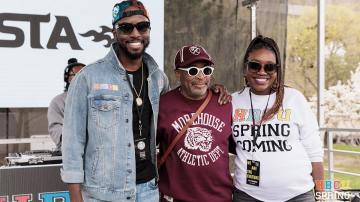Lauren Grove & George A. Peters III Detail How HBCU SpringComing Became A National Family Reunion Rooted In Culture & Community
For over a decade, HBCU SpringComing has served as a vibrant homage to the rich culture and legacy of historically Black colleges and universities, and its founders are celebrating its legacy

For over a decade, HBCU SpringComing has served as a vibrant homage to the rich culture and legacy of historically Black colleges and universities, and its founders are celebrating its legacy.
What began as a grassroots effort to foster connection among HBCU alumni has grown into a national celebration complete with community-building, scholarship fundraising, and joy that spans generations.
At its heart, HBCU SpringComing is more than a party. It’s a spiritual and cultural reunion rooted in shared experiences, legacy, and the deep desire to pour back into the next generation of Black scholars.
“We realized, especially in New York City, you have all these options—CUNYs, SUNYs—that are often more affordable than attending an HBCU,” said HBCU SpringComing co-founder Lauren Grove, a FAMU grad, to OffTheYard. “So, if a student chooses an HBCU, we want to make that dream possible, and any little bit helps.”
To date, HBCU SpringComing has raised over $500,000 in scholarships for incoming HBCU students. And while the number is impressive, Lauren emphasizes the greater purpose of OffTheYard.
“If nothing else happens, we give out scholarships.” Even in tough fundraising years, the founders have reached into their own pockets to make sure students had the resources to take that leap toward Black excellence.
Fellow co-founder George A. Peters III, a Morehouse alum, sees HBCU SpringComing as a continuation of the HBCU legacy—a chance for alumni to recreate that magic in cities far from their alma maters. “New York City doesn’t have an HBCU campus,” he said to OffTheYard. “So, we had to create one—and now they’re on the yard with the babies in their ‘Tuskegee Tykes’ and ‘My First Hampton Tee’ shirts, seeing their parents light up with pride. It’s beautiful.”
That intergenerational magic is no accident. Over the years, HBCU SpringComing has become a space where Black families return year after year, their children growing up surrounded by Black excellence and tradition. “We’ve got HBCU SpringComing babies now,” Lauren laughed to OffTheYard. “Folks saying, ‘My kid has been coming to HBCU SpringComing since they were born.’ Seeing those kids grow up and understand what HBCUs are, even though they live in a city without one, it’s everything.”
Lauren and George both have children now—three between them—who rock “Mini Co-Founder” sweatshirts as a nod to how embedded HBCU SpringComing has become in their lives. “We started this with no kids,” Lauren reflected.
“Now we’re watching our sons and daughters get big, and the community celebrates that right along with us.”
And the love doesn’t stop with the kids. HBCU SpringComing has become a mecca for alumni reconnecting, reigniting old friendships, and even joining local alumni chapters. One year, Lauren remembers finally launching the much-requested alumni and Greek tents on the event website.
“People started using them like a membership fair,” she said to OffTheYard. “Like, ‘Let me find the NYC Hampton crew, because they’ve got a full setup over there!’”
George recalled one unforgettable moment: the time Spike Lee—yes, the legendary filmmaker—showed up at HBCU SpringComing’s School Daze event.
“The word had spread about these scholarships,” he said. “It was supposed to rain that day, but God loves HBCUs, so it didn’t. Spike just showed up—uninvited—to show love. That was surreal. It meant everything.”
That visit was especially meaningful considering Lee’s iconic 1988 film School Daze is a cornerstone of HBCU culture.
“He came to witness the very thing he depicted onscreen decades ago, happening in real life—led by us,” said George to OffTheYard. “It was perfect. The sun came out, and everyone felt like they were at a family reunion.”
The family reunion vibe is intentional. As George puts it, “We’re not a monolith, even if we come from schools that look homogeneous from the outside.”
He recalls his time at Morehouse as transformational. “You realize everyone around you is exceptional, iron sharpening iron, but in their own unique ways. HBCU SpringComing is about rediscovering that magic, post-grad.”
Lauren echoes the sentiment, reflecting on her own journey at FAMU.
“From the moment I stepped foot on campus in the 10th grade, I knew I wanted to be a Rattler,” she said to OffTheYard. “Graduating, pledging Delta Sigma Theta, and meeting my best friends the first week, those are all part of the little moments I treasure.”
Those “little moments” are what HBCU SpringComing is made of. From the scholarship giveaways to the line dances, from kids running around in HBCU onesies to seasoned alumni catching up over plates of food, it’s a joyful reminder that HBCU culture lives far beyond the classroom.
And after ten years of building a thriving, mobile campus in places like New York, LA, and now Birmingham, the HBCU SpringComing team isn’t slowing down. They’re expanding, dreaming bigger, and always staying rooted in the core belief that the legacy of Black education and excellence deserves to be celebrated and sustained.
As George puts it: “HBCU SpringComing is probably the best place to find socially influential, college-educated Black folks in New York City.” And that’s by design.
Because when we show up for each other, whether it’s in classrooms, on campuses, or at pop-up yards in the city, we keep the tradition alive.
And we build a legacy that future generations will be proud to inherit.



